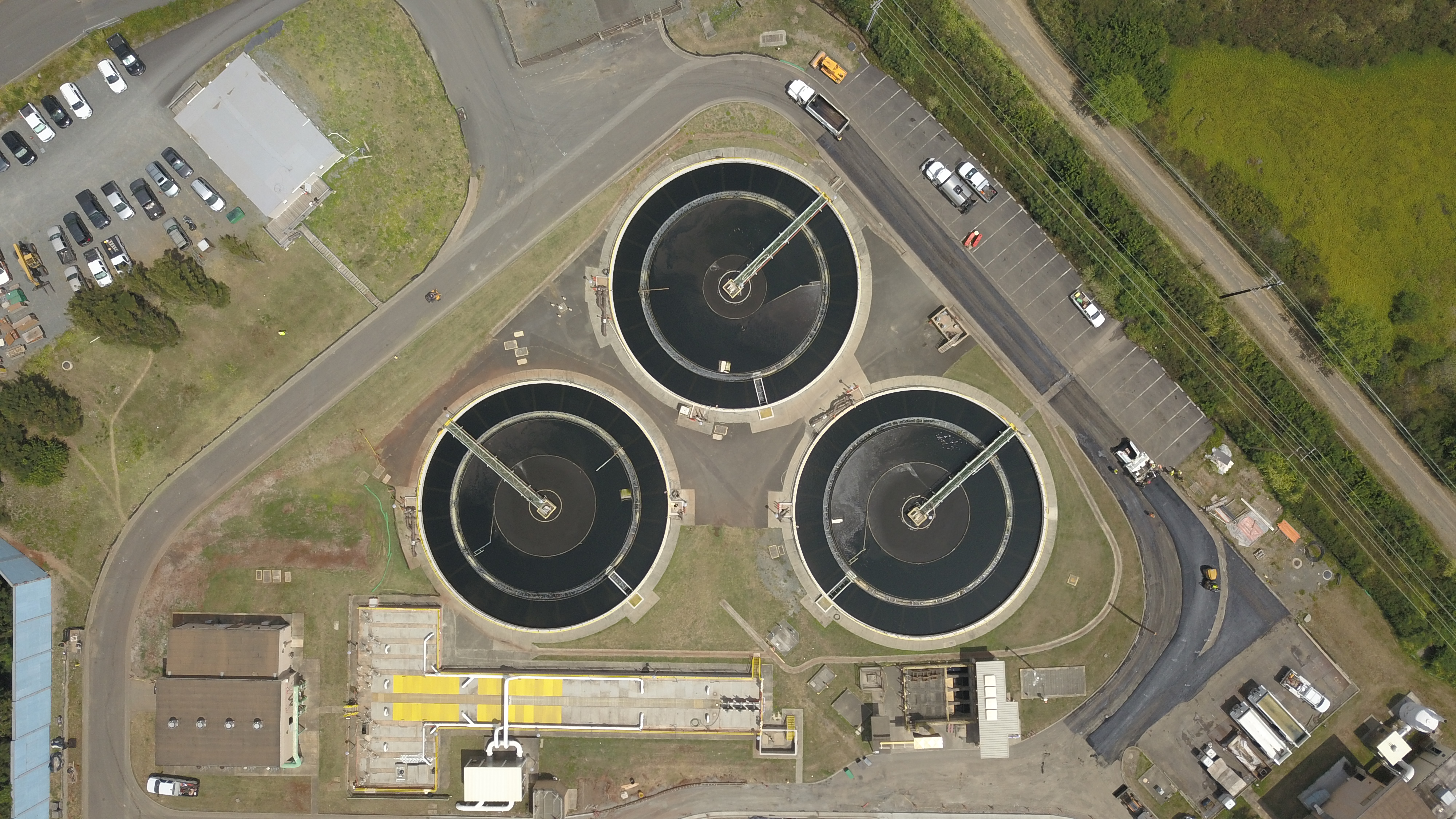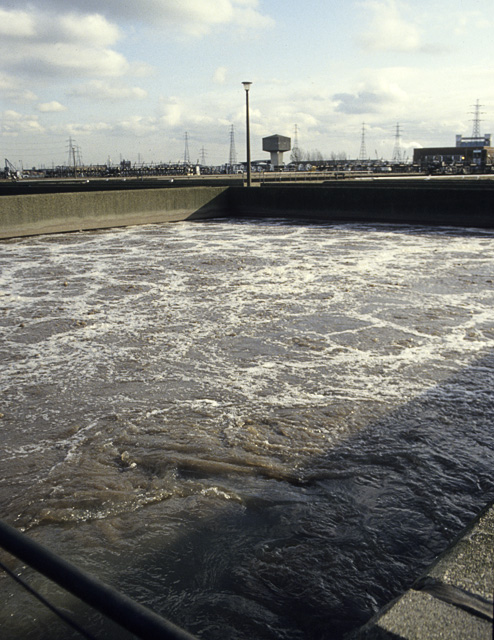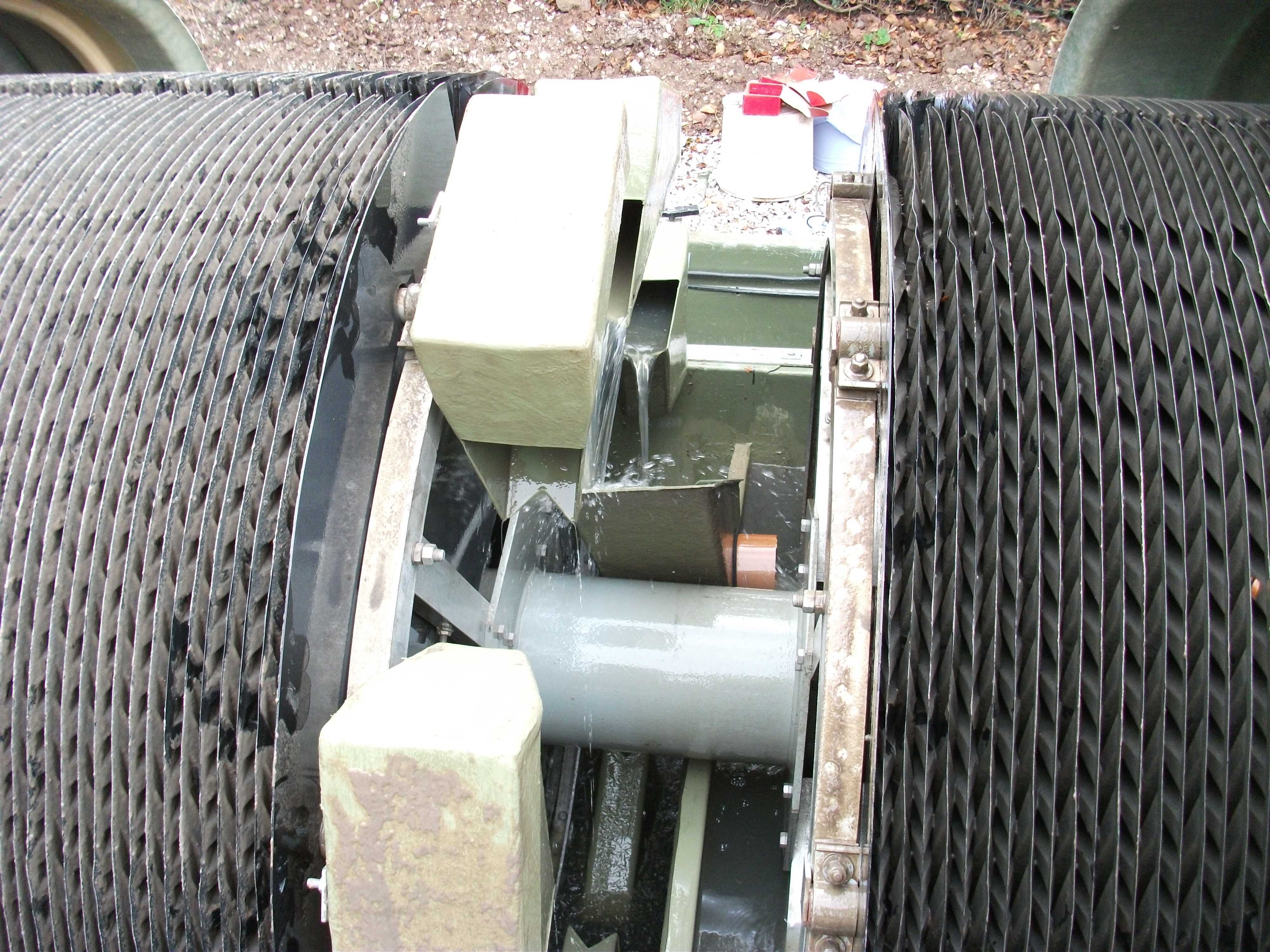|
Clarifier
Clarifiers are settling tanks built with mechanical means for continuous removal of solids being deposited by sedimentation. A clarifier is generally used to remove solid particulates or suspended solids from liquid for clarification and/or thickening. Inside the clarifier, solid contaminants will settle down to the bottom of the tank where it is collected by a scraper mechanism. Concentrated impurities, discharged from the bottom of the tank, are known as sludge, while the particles that float to the surface of the liquid are called scum. Applications Pretreatment Before the water enters the clarifier, coagulation and flocculation reagents, such as polyelectrolytes and ferric sulfate,Brentwood Industries, Inc. (2013)"Tube Settler Systems For Clarification." Accessed 14 October 2013. can be added. These reagents cause finely suspended particles to clump together and form larger and denser particles, called flocs, that settle more quickly and stably. This allows the separation of ... [...More Info...] [...Related Items...] OR: [Wikipedia] [Google] [Baidu] |
Activated Sludge
The activated sludge process is a type of biological wastewater treatment process for treating sewage or industrial wastewaters using aeration and a biological floc composed of bacteria and protozoa. It uses air (or oxygen) and microorganisms to biologically oxidize organic pollutants, producing a waste sludge (or floc) containing the oxidized material. The activated sludge process for removing carbonaceous pollution begins with an aeration tank where air (or oxygen) is injected into the waste water. This is followed by a settling tank to allow the biological flocs (the sludge blanket) to settle, thus separating the biological sludge from the clear treated water. Part of the waste sludge is recycled to the aeration tank and the remaining waste sludge is removed for further treatment and ultimate disposal. Plant types include package plants, oxidation ditch, deep shaft/vertical treatment, surface-aerated basins, sequencing batch reactors (SBRs). Aeration methods include diff ... [...More Info...] [...Related Items...] OR: [Wikipedia] [Google] [Baidu] |
Sedimentation (water Treatment)
Sedimentation is a physical water treatment process using gravity to remove suspension (chemistry), suspended solids from water. Solid particles entrained by the turbulence of moving water may be removed naturally by sedimentation in the still water of lakes and oceans. Settling basins are ponds constructed for the purpose of removing entrained solids by sedimentation. Clarifiers are tanks built with mechanical means for continuous removal of solids being deposited by sedimentation. Clarification does not remove dissolved species. Sedimentation is the act of depositing sediment. Basics Suspended solids (or SS), is the mass of dry solids retained by a water filter, filter of a given porosity related to the volume of the water sample. This includes particles 10 μm and greater. Colloids are particles of a size between 1 nm (0.001 µm) and 1 µm depending on the method of quantification. Because of Brownian motion and electrostatics, electrostatic forces balancing ... [...More Info...] [...Related Items...] OR: [Wikipedia] [Google] [Baidu] |
Sedimentation Tank
Sedimentation is a physical water treatment process using gravity to remove suspended solids from water. Solid particles entrained by the turbulence of moving water may be removed naturally by sedimentation in the still water of lakes and oceans. Settling basins are ponds constructed for the purpose of removing entrained solids by sedimentation. Clarifiers are tanks built with mechanical means for continuous removal of solids being deposited by sedimentation. Clarification does not remove dissolved species. Sedimentation is the act of depositing sediment. Basics Suspended solids (or SS), is the mass of dry solids retained by a filter of a given porosity related to the volume of the water sample. This includes particles 10 μm and greater. Colloids are particles of a size between 1 nm (0.001 µm) and 1 µm depending on the method of quantification. Because of Brownian motion and electrostatic forces balancing the gravity, they are not likely to settle naturally ... [...More Info...] [...Related Items...] OR: [Wikipedia] [Google] [Baidu] |
Sewage Treatment
Sewage treatment (or domestic wastewater treatment, municipal wastewater treatment) is a type of wastewater treatment which aims to remove contaminants from sewage to produce an effluent that is suitable for discharge to the surrounding environment or an intended reuse application, thereby preventing water pollution from raw sewage discharges. Sewage contains wastewater from households and businesses and possibly pre-treated industrial wastewater. There are a high number of sewage treatment processes to choose from. These can range from decentralized systems (including on-site treatment systems) to large centralized systems involving a network of pipes and pump stations (called sewerage) which convey the sewage to a treatment plant. For cities that have a combined sewer, the sewers will also carry urban runoff (stormwater) to the sewage treatment plant. Sewage treatment often involves two main stages, called primary and secondary treatment, while advanced treatment also incor ... [...More Info...] [...Related Items...] OR: [Wikipedia] [Google] [Baidu] |
Water Purification
Water purification is the process of removing undesirable chemicals, biological contaminants, suspended solids, and gases from water. The goal is to produce water that is fit for specific purposes. Most water is purified and disinfected for human consumption (drinking water), but water purification may also be carried out for a variety of other purposes, including medical, pharmacological, chemical, and industrial applications. The history of water purification includes a wide variety of methods. The methods used include physical processes such as filtration, sedimentation, and distillation; biological processes such as slow sand filters or biologically active carbon; chemical processes such as flocculation and chlorination; and the use of electromagnetic radiation such as ultraviolet light. Water purification can reduce the concentration of particulate matter including suspended particles, parasites, bacteria, algae, viruses, and fungi as well as reduce the concentration of ... [...More Info...] [...Related Items...] OR: [Wikipedia] [Google] [Baidu] |
Water Purification
Water purification is the process of removing undesirable chemicals, biological contaminants, suspended solids, and gases from water. The goal is to produce water that is fit for specific purposes. Most water is purified and disinfected for human consumption (drinking water), but water purification may also be carried out for a variety of other purposes, including medical, pharmacological, chemical, and industrial applications. The history of water purification includes a wide variety of methods. The methods used include physical processes such as filtration, sedimentation, and distillation; biological processes such as slow sand filters or biologically active carbon; chemical processes such as flocculation and chlorination; and the use of electromagnetic radiation such as ultraviolet light. Water purification can reduce the concentration of particulate matter including suspended particles, parasites, bacteria, algae, viruses, and fungi as well as reduce the concentration of ... [...More Info...] [...Related Items...] OR: [Wikipedia] [Google] [Baidu] |
Rotating Biological Contactor
A rotating biological contactor or RBC is a biological fixed-film treatment process used in the secondary treatment of wastewater following primary treatment. The primary treatment process involves removal of grit, sand and coarse suspended material through a screening process, followed by settling of suspended solids. The RBC process allows the wastewater to come in contact with a biological film in order to remove pollutants in the wastewater before discharge of the treated wastewater to the environment, usually a body of water (river, lake or ocean). A rotating biological contactor is a type of secondary (biological) treatment process. It consists of a series of closely spaced, parallel discs mounted on a rotating shaft which is supported just above the surface of the wastewater. Microorganisms grow on the surface of the discs where biological degradation of the wastewater pollutants takes place. Rotating biological contactors (RBCs) are capable of withstanding surges in org ... [...More Info...] [...Related Items...] OR: [Wikipedia] [Google] [Baidu] |
List Of Waste-water Treatment Technologies
This page consists of a list of wastewater treatment technologies: See also *Agricultural wastewater treatment *Industrial wastewater treatment *List of solid waste treatment technologies * Waste treatment technologies *Water purification *Sewage sludge treatment Sewage sludge treatment describes the processes used to manage and dispose of sewage sludge produced during sewage treatment. Sludge treatment is focused on reducing sludge weight and volume to reduce transportation and disposal costs, and on red ... References * * Industrial Wastewater Treatment Technology DatabaseEPA. {{DEFAULTSORT:List Of Waste Water Treatment Technologies Chemical processes Environmental engineering *List Water pollution Water technology Waste-water treatment technologies Sanitation ... [...More Info...] [...Related Items...] OR: [Wikipedia] [Google] [Baidu] |
Trickling Filter
A trickling filter is a type of wastewater treatment system. It consists of a fixed bed of rocks, coke, gravel, slag, polyurethane foam, sphagnum peat moss, ceramic, or plastic media over which sewage or other wastewater flows downward and causes a layer of microbial slime (biofilm) to grow, covering the bed of media. Aerobic conditions are maintained by splashing, diffusion, and either by forced-air flowing through the bed or natural convection of air if the filter medium is porous. The treatment of sewage or other wastewater with trickling filters is among the oldest and most well characterized treatment technologies. The fundamental components of a complete trickling filter system are: * a bed of filter medium upon which a layer of microbial slime is promoted and developed; * an enclosure or a container which houses the bed of filter medium; * a system for distributing the flow of wastewater over the filter medium; and * a system for removing and disposing of any sludge fr ... [...More Info...] [...Related Items...] OR: [Wikipedia] [Google] [Baidu] |
Flocculation
Flocculation, in the field of chemistry, is a process by which colloidal particles come out of suspension to sediment under the form of floc or flake, either spontaneously or due to the addition of a clarifying agent. The action differs from precipitation in that, prior to flocculation, colloids are merely suspended, under the form of a stable dispersion (where the internal phase (solid) is dispersed throughout the external phase (fluid) through mechanical agitation) and are not truly dissolved in solution. Coagulation and flocculation are important processes in water treatment with coagulation aimed to destabilize and aggregate particles through chemical interactions between the coagulant and colloids, and flocculation to sediment the destabilized particles by causing their aggregation into floc. Term definition According to the IUPAC definition, flocculation is "a process of contact and adhesion whereby the particles of a dispersion form larger-size clusters". Flocculation ... [...More Info...] [...Related Items...] OR: [Wikipedia] [Google] [Baidu] |
Dissolved Air Flotation
Dissolved air flotation (DAF) is a water treatment process that clarifies wastewaters (or other waters) by the removal of suspended matter such as oil or solids. The removal is achieved by dissolving air in the water or wastewater under pressure and then releasing the air at atmospheric pressure in a flotation tank basin. The released air forms tiny bubbles which adhere to the suspended matter causing the suspended matter to float to the surface of the water where it may then be removed by a skimming device. Dissolved air flotation is very widely used in treating the industrial wastewater effluents from oil refineries, petrochemical and chemical plants, natural gas processing plants, paper mills, general water treatment and similar industrial facilities. A very similar process known as '' induced gas flotation'' is also used for wastewater treatment. ''Froth flotation'' is commonly used in the processing of mineral ores. In the oil industry, ''dissolved gas flotation'' (DGF) un ... [...More Info...] [...Related Items...] OR: [Wikipedia] [Google] [Baidu] |
Stokes' Law
In 1851, George Gabriel Stokes derived an expression, now known as Stokes' law, for the frictional force – also called drag force – exerted on spherical objects with very small Reynolds numbers in a viscous fluid. Stokes' law is derived by solving the Stokes flow limit for small Reynolds numbers of the Navier–Stokes equations.Batchelor (1967), p. 233. Statement of the law The force of viscosity on a small sphere moving through a viscous fluid is given by: :F_ = 6 \pi \mu R v where: * ''F''d is the frictional force – known as Stokes' drag – acting on the interface between the fluid and the particle * ''μ'' is the dynamic viscosity (some authors use the symbol ''η'') * ''R'' is the radius of the spherical object * ''v'' is the flow velocity relative to the object. In SI units, ''F''d is given in newtons (= kg m s−2), ''μ'' in Pa·s (= kg m−1 s−1), ''R'' in meters, and ''v'' in m/s. Stokes' law makes the following assumptions for the behavior of a particle i ... [...More Info...] [...Related Items...] OR: [Wikipedia] [Google] [Baidu] |








_model_Biosow-FB2.jpg)